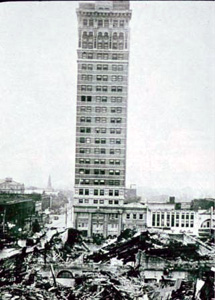|duration= parameter from the infobox header or from another 'History' box instead. The ALICO building looming over the destroyed downtown area of Waco. | |
| Meteorological history | |
|---|---|
| Duration | May 9-11, 1953 |
| Tornado outbreak | |
| Tornadoes | 33 |
| Maximum rating | F5 tornado |
| Overall effects | |
| Fatalities | 144 fatalities 895 injuries |
| Damage | ≥$800 million[1] |
| Areas affected | Great Plains, West North Central and East North Central States |
Part of the tornado outbreaks of 1953 | |
A deadly series of at least 33 tornadoes hit at least 10 different U.S. states on May 9–11, 1953. Tornadoes appeared daily from Minnesota in the north to Texas in the south. The strongest and deadliest tornado was a powerful F5 tornado[nb 1] that struck Waco, Texas on May 11, causing 114 of the 144 deaths in the outbreak. Alongside the 1902 Goliad tornado, it was the deadliest tornado in Texas history and is the 11th deadliest tornado in U.S. history. The tornado's winds demolished more than 600 houses, 1,000 other structures, and over 2,000 vehicles. 597 injuries occurred, and many survivors had to wait more than 14 hours for rescue. The destruction dispelled a myth that the geography of the region spared Waco from tornadoes, and along with other deadly tornadoes in 1953, the Waco disaster was a catalyst for advances in understanding the link between tornadoes and radar-detected hook echoes. It also generated support for improved civil defense systems, the formation of weather radar networks, and improved communications between stakeholders such as meteorologists, local officials, and the public.
The Waco tornado was not the only deadly and damaging tornado in the outbreak sequence. On the same day as the Waco disaster, a high-end F4 tornado struck the Texas city of San Angelo, causing catastrophic damage, killing 13 people, and injuring more than 150. The tornado swept away numerous homes and damaged a school, but students inside escaped without serious injuries. On May 9, a long-tracked F3 tornado destroyed a large swath of Hebron, Nebraska and killed five people in the area. The following day, May 10, featured numerous, often long-tracked and intense tornado families across the states of Iowa, Minnesota, and Wisconsin. Two families on nearly parallel paths traveled more than 100 miles (160 km) each and killed a combined total of six people, mostly in Wisconsin. At least one of the tornado families reached F4 intensity in Wisconsin. Two other F4 tornadoes also struck Iowa. Additionally, a relatively moderate tornado of F2 intensity caused significant loss of life in a shack in Minnesota, killing six people. Although 33 tornadoes were officially registered from May 9–11, others likely occurred but either went undetected or were not officially documented.
- ^ "May 9-11, 1953 Tornadoes". National Centers for Environmental Information. National Weather Service. Retrieved 5 May 2022.
- ^ Grazulis, Thomas P. (2001). The Tornado: Nature's Ultimate Windstorm. Norman: University of Oklahoma Press. p. 141. ISBN 978-0-8061-3538-0.
- ^ Edwards, Roger (5 March 2015). "Enhanced F Scale for Tornado Damage". The Online Tornado FAQ (by Roger Edwards, SPC). Storm Prediction Center. Retrieved 25 February 2016.
- ^ "Enhanced Fujita Scale (EF-Scale)". Environment and Climate Change Canada. 6 June 2013. Archived from the original on 3 March 2016. Retrieved 25 February 2016.
- ^ "The International Tornado Intensity Scale". Tornado and Storm Research Organisation. 2016. Archived from the original on 5 March 2016. Retrieved 25 February 2016.
Cite error: There are <ref group=nb> tags on this page, but the references will not show without a {{reflist|group=nb}} template (see the help page).